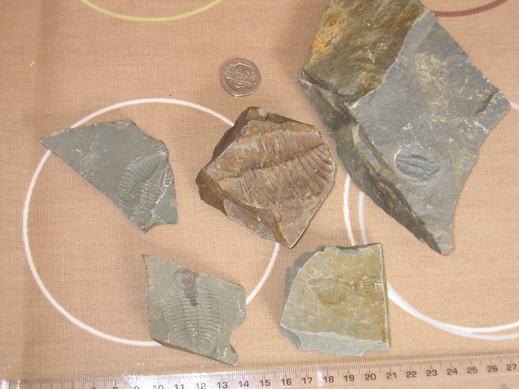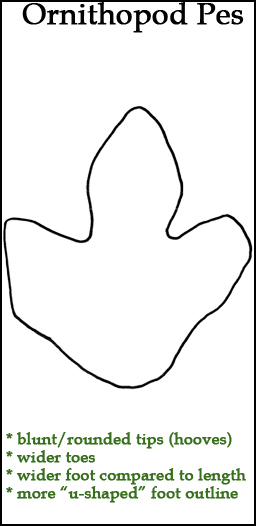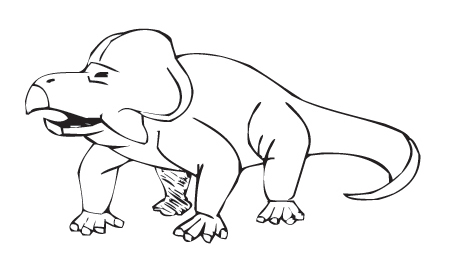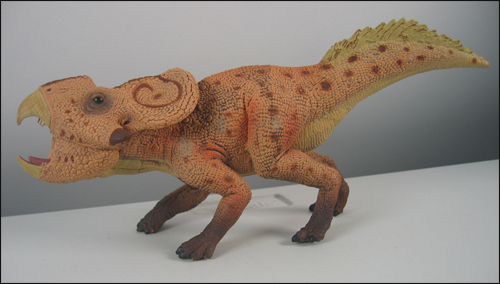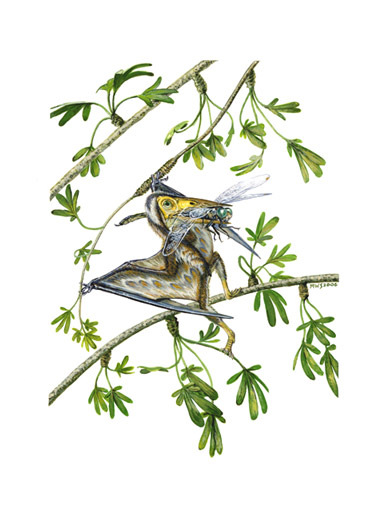Giant Frog challenges Scientists over movement of Continents
Frogs are the most common type of amphibian alive today, with an estimated 5,500 separate species, making them the most diverse and successful clade of the Lissamphibians. They are known from all the continents except Antarctica but their fossil record is quite poor. Although very much extant, scientists still debate how many actual families make up the order containing frogs and toads – Anura. With discussion ongoing as to how to classify frogs and toads around today, it is no wonder that difficulties arise when trying to piece together the development and relationships between elements of Anura when you consider how sparse the fossil evidence is.
Now the discovery of a giant, Late Cretaceous frog from Madagascar that may be related to the horned frogs of South America, has opened up the debate once again over frog family ancestry and the break up of the super-continent Gondwanaland.
Frog and Toad Evolution
Frogs and toads are very specialised Lissamphibians with a body shape (morphology) unlike their living relatives and their ancient amphibian ancestors from the Palaeozoic. In comparison with other amphibian groups, they have dramatically reduced skeletons, lacking ribs, a tail, with a simple pelvic girdle and relatively few vertebrae. One of the earliest known frogs was also found in Madagascar, called Triadobatrachus; this animal dates back to the Triassic.
Frogs and toads were probably relatively abundant during the Mesozoic but the lack of fossil evidence inhibits palaeontologists when it comes to working out Anura evolution. Fossil bones have been recorded from a number of Mesozoic sites but they are usually isolated fragments, ilia, humeri (limb bones) and the more robust skull elements such as the frontoparietals and squamosals – elements from the top and towards the rear of the skull respectively. Some upper jaws bones (maxillae) have also been located and it is the jaws and the partial skull elements that provide the greatest assistance to palaeontologists when they attempt to work out the relationships between extinct genera and species.
Researchers Study Fossil Bones
Researchers from New York’s Stony Brook University aided by a team from University College, London headed up by vertebrate morphologist and palaeontologist Susan Evans; have published their findings on this new species of Madagascan giant frog in the journal Proceedings of the National Academy of Sciences.
This discovery, led by David Krause of Stony Brook University may undermine current scientific thinking over the isolation of Madagascar that was believed to have taken place in the Cretaceous. Conventional theory states that by approximately 95 million years ago, the land mass that was to eventually form India and Madagascar had split away from Africa, part of the break up of Gondwanaland (Australia, New Zealand, Africa, Antarctica and South America). Over the next 30 million years or so a rising plume of hot magma forced its way through a fault rifting apart India and Madagascar. Madagascar was left an isolated island with its own distinct indigenous fauna and flora and India went northwards to collide with Asia.
Beelzebufo ampinga
The fossilised bones of Beelzebufo ampinga, a frog the size of a partially deflated beach ball and tipping the scales at around 4 kilogrammes, making it the largest frog found to date, resemble the bones of the extant frog group – the Ceratophyrinae. The Ceratophyrinae, termed the “horned frogs” as many members of this family have soft extensions of skin growing out from the upper eyelid, which resemble little horns; are associated with South America.
Study of the fossils have indicated that this ancient animal is not related to any of the frog species living on Madagascar today. If Madagascar was very much an isolated island when Beelzebufo was hopping around, then how do scientists explain a member of the Ceratophyrinae group on an island thousands of miles away from their ancestral home of the South Americas.
Beelzebufo – the Frog from Hell
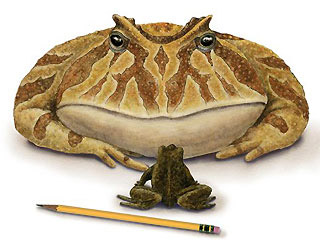
Picture credit: Associated Press
The diagram above shows an artist’s impression of Beelzebufo, with a modern frog and a pencil for scale. Although only partial elements of the skeleton have been recovered Krause and his team estimate that this animal was 40 cm long and would have weighed as much as a large domestic cat.
The most characteristic feature of the Ceratophyrinae is not their horned eyelids (some members of the group do not possess this feature), but their large heads, huge mouths and blunt snouts. They are voracious and unfussy hunters, lying half submerged in mud waiting for any unsuspecting small animal to wander by. Basically, anything that can fit into their mouths is on the menu, mice, frogs, snakes, fish and such like.
Wide Mouth and Powerful Jaws
Beelzebufo had a very wide mouth and powerful jaws, plus teeth. The skull material recovered has ridges and groves on it; perhaps indicating that this animal had bony armour or a protective head shield.
David Krause commented: “This frog, if it has the same habits as its living relatives in South America, was quite voracious. It’s even conceivable that it could have taken down some hatchling dinosaurs.”
The name Beelzebufo is a derivative of the Greek word for Devil and bufo is the Latin for toad. The “Devil Toad” would be an apt title for a frog capable of swallowing whole baby dinosaurs.
Krause and his team began finding fragments of abnormally large frog bones whilst studying the late Cretaceous sediments of the Mahajganga basin in north-western Madagascar in 1993. Amongst the various dinosaur and crocodilian fossils a total of 60 fossil frog bone fragments were located during a number of expeditions to the area by the New York team.
A Relative of Extant Horned Frogs
The unusually large frog bones were sent to the University College, London for specialist Susan Evans to examine. The London researchers were not able to piece together a complete skeleton but they had enough of the skull elements to make a diagnosis and interpret Beelzebufo as a relative of the horned frogs group.
The giveaway clinching evidence was the skull material indicating a “short, fat skull with a huge mouth”, says Evans.
Scale Drawing of Beelzebufo Skeleton compared to Living Frogs
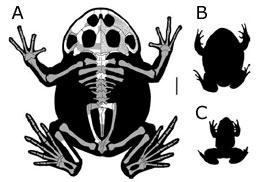
Big frog from the Mesozoic.
Picture credit: Journal of Proceedings of the National Academy of Sciences
The drawing depicts the skeleton of Beelzebufo ampinga (A) compared to the largest extant member of the South American Ceratophyrs (B) and the largest frog species found on Madagascar today (C). The skeletal material in white represents bones found, those parts of Beelzebufo skeleton in grey are a scientific impression as to what the remainder of the skeleton would have looked like.
A Palaeontology Puzzle
The link to South America raises a palaeontology puzzle. Standard theory for how the continents drifted apart show what is now Madagascar would have been long separated by ocean from the Americas during Beelzebufo’s time. Frogs with their soft permeable skins cannot survive long in salt water, so reaching Madagascar by swimming can be ruled out.
Krause contends that the giant frog provides evidence for competing theories that some bridge still connected the land masses that late in time, perhaps via Antarctica that was much warmer than today. Perhaps Gondwanaland stayed together for longer than scientists currently think, could India/Madagascar have been linked to South America by an Antarctica land bridge as recently as the late Cretaceous.
Evans says that when she first began to suspect the Madagascar fragments came from a frog related to South American Ceratophryinae, she was very cautious about the claim. “We knew it would be controversial,” she says. “There are people who believe everything on Madagascar today must have been there when it broke with Gondwanaland 160 million years ago.”
Blair Hedges, a biologist at Pennsylvania State University in University Park, agrees that Beelzebufo is an important find. “The new fossil frog, besides being large and odd-shaped, is quite unexpected because of its apparent relationship with South American species,” he says.
But he says he isn’t yet convinced that the new find is related to the South American frogs. Molecular clock data suggests that these frogs split from a common ancestor more recently than 66 million years ago, he says. “Based on molecular evidence of frog relationships, the specific resemblance to some living wide-mouthed frogs is more likely from [evolutionary] convergence than actual relationship.” Convergent evolution, where unrelated species occupying similar niches tend to look the same, is common in frogs, he says.
Even if they are related, he adds, this doesn’t mean that the frogs necessarily had to walk on land from one location to another before Gondwana split. “Any organism, including a frog, can raft on dead vegetation,” he says.
Flood events and tropical storms can wash relatively large pieces of vegetation out to sea, some of these “rafts” get washed up on foreign shores. A number of animals migrate between islands today under these circumstances.
Susan Evans and her team remain convinced that Beelzebufo is a relative of the horned frogs of the Americas and refutes the convergence evolution theory. “It is the same family. I have no doubt of that,” she says.
It seems that this large, voracious frog – a trouble maker back in the Mesozoic, eating anything that could fit in its mouth, is going to be causing just as much trouble in scientific circles here in the Holocene.
Visti Everything Dinosaur’s website: Everything Dinosaur.


